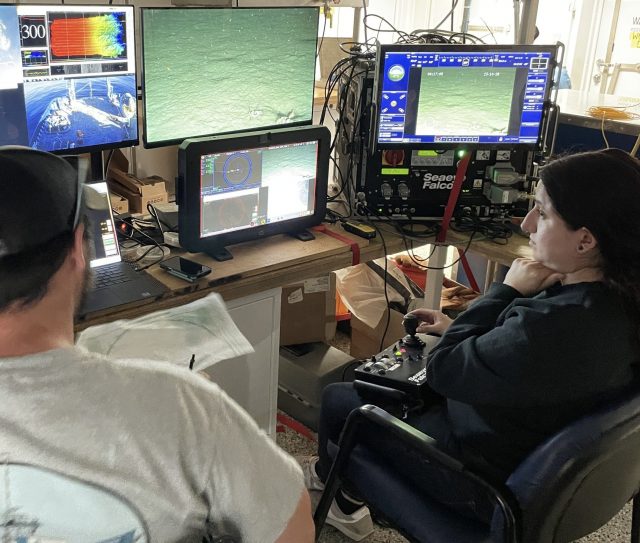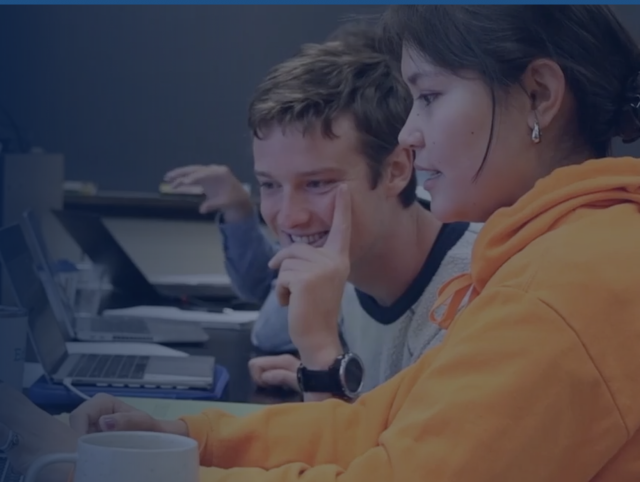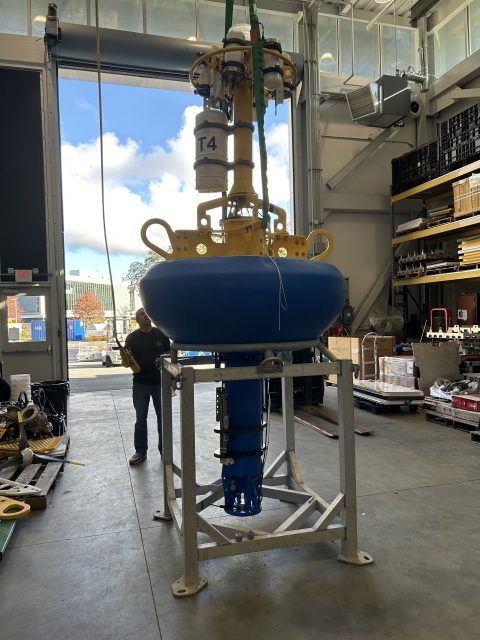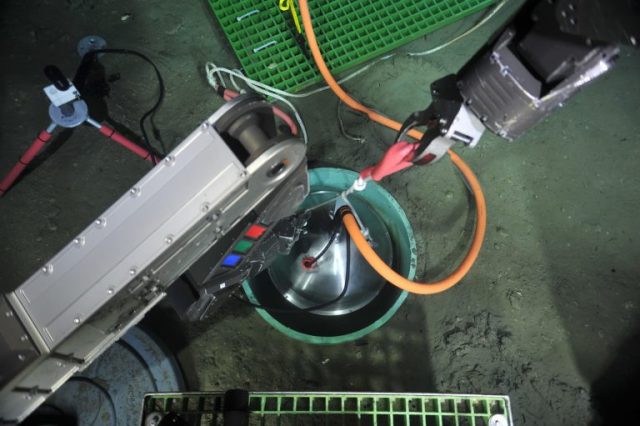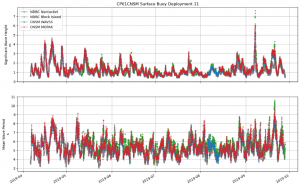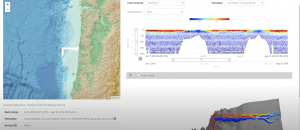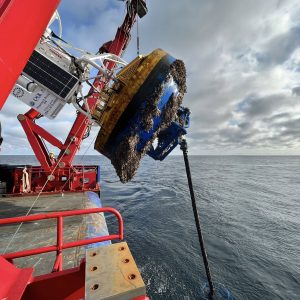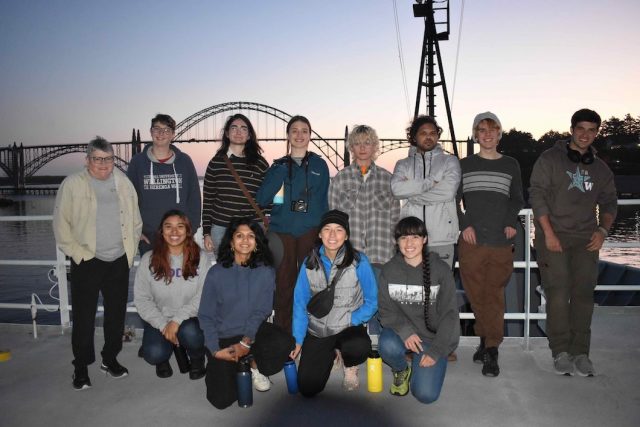News
Optimizing Ocean Observing Networks for Detecting the Coastal Climate Signal
Society experiences changes in the global ocean through the ocean’s boundaries. While climate change is certain, its effects in coastal and ocean boundary regions vary considerably geographically. The climate signal is the link between the broader changing climate and the resulting events, which manifests differently in coastal areas than in the open ocean. The U.S. territorial waters encompass 11 Large Marine Ecosystems (LMEs) that range from the cold waters of the Arctic to the tropical waters of the Pacific Islands, and include the Great Lakes that are the world’s largest system of freshwater lakes. As climate change leads to a warmer ocean, LMEs will be exposed to increasing stressors, and coastal communities will be more vulnerable to the effects of climate anomalies. Under these circumstances, it is key to develop a framework that improves the link between larger scale climate variability in the open ocean and its signatures along the coasts.
Objectives
This workshop will bring together operators and users of coastal ocean observing systems to identify the key science issues that need to be resolved to detect and respond to coastal climate change in the coming decades. To achieve this, the workshop will:
- Identify opportunities to accelerate the co-design and optimization of observing systems for detecting the coastal climate signal by integrating knowledge, data, and approaches.
- Foster collaborations between the climate science, operational oceanographic, research, and resource management communities to inform first responder agencies in the management and mitigation of coastal vulnerability to both event-scale and long-term climate changes.
- Bridge gap between global climate research and regional operational oceanography at the coasts.
Outcomes
Deliverables include:
- A workshop report that articulates ways for optimizing global and coastal observing systems to capture the coastal climate signal and address society’s needs for better coastal climate information.
- Identification of coastal climate signals and specific observational metrics needed to track local and regional impacts, including ecosystems and human health.
- Recommendations to be considered by the nascent IOOC Coastal Climate Signal Task Team
Learn more and register here.
Another Round of Pioneer MAB At-Sea Tests Completed
A team of OOI Coastal and Global Scale Nodes (CGSN) scientists and engineers returned to Woods Hole, MA aboard the R/V Neil Armstrong on November 4, having successfully completed another round of tests of mooring equipment and site location surveys for the proposed relocation of the Coastal Pioneer Array to the Mid-Atlantic Bight (MAB), off the coast of Cape Hatteras, NC.
[media-caption path="https://oceanobservatories.org/wp-content/uploads/2023/11/IMG_6640-2048x2048-2.jpg" link="#"]The OOI-CGSN team surveyed the seabed to better understand the environment for the proposed moorings sites. The RV Neil Armstrong operated hull-mounted acoustic equipment to collect bathymetry (depth contours; shown left ), backscatter imagery (seabed characterization), and sub bottom data (seabed profile and geophysical layering). Chris Basque and Irene Duran (shown right) also piloted the ROV over the mooring locations to collect still images, video, and high-resolution sonar of the seabed. Photos: Sheri N. White © WHOI.[/media-caption] [media-caption path="https://oceanobservatories.org/wp-content/uploads/2023/11/IMG_6643-1536x1536-1.jpg" link="#"]Closeup of multi-beam survey.[/media-caption]Having accomplished all of the primary cruise objectives under un-seasonally warm and calm conditions, the weather picked up at the MAB as they were finishing up the last two CTD (Conductivity, Temperature, and Depth) surveys along the proposed location of the main mooring lines.
The team then headed north to conduct a final ROV survey of the Shallow Water test mooring they had put in place the week before in 32 meters of water southwest of Martha’s Vineyard. This ROV inspection was the second conducted at this mooring location. A first inspection was done shortly after the mooring’s deployment, when all components were found to be in place and operational. The second confirmed the earlier findings.
In addition to deployment of the Shallow Water test mooring off Martha’s Vineyard, the CGSN team conducted recovery operations onsite at MAB. They recovered the Coastal Profiler Mooring anchor, deployed in the spring of 2023. The mooring itself had been recovered in August of this year. The team also recovered the Coastal Surface Mooring after ~8 months operating at the proposed Pioneer MAB location. The mooring was deployed in a water depth of 30 m and survived storms with max wave heights of 7.5-10 m and continued to send data to shore!
[media-caption path="https://oceanobservatories.org/wp-content/uploads/2023/11/IMG_6642-1536x1536-1.jpg" link="#"]The Coastal Surface Mooring is safely on deck after ~8 months operating at the proposed Pioneer Mid-Atlantic Bight location. Credit: Sheri N. White © WHOI.[/media-caption]Other activities conducted during the 11-day expedition included a site surveys (utilizing multi-beam, sub-bottom, and ROV) of alternate mooring locations, and cross-shelf and along-shelf CTD surveys to better understand the oceanographic conditions in the Mid-Atlantic Bight.
“Conducting at-sea tests of our infrastructure and detailed environmental surveys of the environment are important to ensure the success of new OOI Array,” said Sheri N. White, Chief Scientist for the recovery cruise. “We were lucky to have excellent weather for our deployment and recovery cruises. But also pleased that our test moorings experienced challenging weather during the deployment. This gives us the confidence that the moorings can operate successfully in the new environment and collect data year-round.” The plan is to deploy the Coastal Pioneer Array in its new location in spring 2024.
More details about and images from the expedition can be found here.
Read MoreNSF Announces Grants Related to OOI Education; Funding Opportunities Remain
The Ocean Sciences Division (OCE) of the National Science Foundation recently announced two awards related to Ocean Observatories Initiative (OOI) education: a renewal of the OOI Data Labs with Rutgers University and a microcredentialing program at the Marine Technology Society (MTS). The Data Labs project offers opportunities for OOI data users’ participation, and the MTS project will provide a widely available microcredential badging opportunity within a few years.
The OOI Data Labs involves representatives of Rutgers University, Stockton University, Hillsborough Community College, City University of New York Queens College, and the Science Education Resources Center at Carleton College, who will support curriculum development and student engagement using advanced technologies of the OOI. Under previous NSF funding, Ocean Data Labs successfully created and tested a lab manual that includes a collection of laboratory exercises using OOI data, as well as holding hands-on workshops where students and faculty learned how to use OOI data to answer ocean-related science questions.
The MTS award will be used to establish a microcredentialing program to address core competencies required for employment in the blue economy. Microcredentials are short, competency-based recognition that allows a learner to demonstrate mastery in specific areas. By 2025, MTS aims to offer six microcredentials, including a foundational microcredential in Underwater Gliders, Remotely Operated Vehicles (ROVs), Sonar, and Deck Operations. Rutgers University and Northwestern Michigan College will be developing the program along with MTS.
“NSF is pleased to support both these projects that promise expanded use of OOI data in the classroom and skills that will promote competency in some of the advanced technology used by OOI to collect data,” said Elizabeth Rom, Program Director of NSF’s Directorate of Geosciences. “We continue to seek innovative proposals that can serve to integrate OOI data more broadly into the learning and scientific community. We are seeking to support efforts that teach researchers or educators how to use OOI data and tools, that develop additional tools or instructional materials using OOI data or that serve to create communities of practice to use OOI data for multi-investigator, community-driven research.”
Rom provide details of three open funding opportunities:
- NSF 22-059 Dear Colleague Letter that encourages curriculum development proposals with the goal of improving the education of the next generation of ocean technicians, data scientists, ocean engineers, and ocean scientists.
- NSF 23-134 Dear Colleague Letter that encourages workshop proposals to develop connections between academic departments and ocean industries, ocean technicians, data scientists, ocean engineers, and ocean scientists.
- NSF 21-24 Dear Colleague Letter encourages research addressing Critical Aspects of Sustainability (CAS) related to climate change solutions. Proposals addressing cross-cutting topics could focus on technology and workforce development with an emphasis on behavioral and social aspects related to climate mitigation and adaptation. Potential relevant topics in red may include:
o Measurement and sensing innovations;
o Artificial Intelligence and other data analytics, computational and statistical modeling and simulation approaches that directly address climate change solutions;
o Understanding the role of human behavior in achieving mitigation strategies;
o Energy and climate education, capacity building, and broadening participation.
Article was posted on October 26, 2023.
Read MorePioneer Mid-Atlantic Bight At-Sea Tests Continue
On Monday October 23, 2023, a team of scientists and engineers from Woods Hole Oceanographic Institution (WHOI) left Woods Hole, MA aboard the R/V Neil Armstrong to conduct a variety of at-sea tests to continue preparations for the anticipated move of the Coastal Pioneer Array to the Mid-Atlantic Bight (MAB), off Cape Hatteras, NC. The science team first traveled to a site off the coast of Martha’s Vineyard to deploy a newly designed shallow water mooring (SWM). This test deployment site was chosen because it offers suitable conditions to test the moorings performance in a shallow water environment, with easy access from Woods Hole, simplifying monitoring and recovery.
The mooring will be deployed for a few months to test the seabed multifunction node, buoyant stretch hose, riser cable, and Prawler profiling vehicle. Engineering data will be collected and assessed prior to the SWM’s deployment at the proposed Pioneer Mid-Atlantic Bight in Spring 2024.
[media-caption path="https://oceanobservatories.org/wp-content/uploads/2023/10/Pioneer-MAB-schematic.png" link="#"]Schematic drawing of the proposed Pioneer MAB moored array to be deployed off the coast of Nags Head, North Carolina. The full array, proposed to be deployed in the spring of 2024, would consist of ten moorings at seven different sites (three sites contain mooring pairs). For the test deployment, one Coastal Surface Mooring was deployed at the Central site and one Coastal Profiler Mooring was deployed at the Northeast site.[/media-caption]From there, the team will head to the Mid-Atlantic Bight to recover a mooring and two anchors that have been in place since spring 2023. Other activities will include a multibeam and sub-bottom site survey and ROV inspection of alternate sites. Water and CTD sampling will be conducted at various depths at the proposed mooring locations. Ancillary science activities will be conducted as time allows. The public comment period on the environmental assessment of the new location is open until October 30, 2023.
“The goal of our test cruises is to evaluate our mooring designs and instrument sampling strategies, and collect environmental data at the new location. This will help to ensure a successful first deployment in the spring of 2004,” said Sheri N. White, Chief Scientist for this expedition and a senior engineer at WHOI. “Understanding the seafloor and water column conditions in the Mid-Atlantic Bight will help us to confirm the optimum locations for the moorings and paths for the gliders and AUVs.”
“This new location in the MAB offers many opportunities for scientists to obtain data to further their research and will provide better insight into conditions in the area for a variety of stakeholders, “said Al Plueddemann, Project Scientist for OOI’s Coastal and Global Scale Nodes group at WHOI, which is responsible for operation of the Pioneer Array. “We welcome researchers, educators, and industry members to reach out to us to explore ways we might work together to maximize the usefulness of the data.”
The new MAB site offers opportunities to collect data on a variety of cross-disciplinary science topics, including cross-shelf exchange and Gulf Stream influences, land-sea interactions associated with large estuarine systems, a highly productive ecosystem with major fisheries, processes driving biogeochemical cycling and transport, and fresh-water outflows during extreme rain events.
The test mooring data will be evaluated during the deployment and after recovery to determine whether any modifications are needed to the mooring designs. The full array will be deployed at the new Mid-Atlantic Bight location in the spring 2024. The At-Sea Test expedition team is expected to return to Woods Hole in early November.
Read More
NSF Funds Creation of Offshore Subduction Zone Observatory as part of OOI’s Regional Cabled Array
With support from the US National Science Foundation, the Ocean Observatories Initiative’s (OOI) Regional Cabled Array (RCA) will be expanded to include an Offshore Subduction Zone Observatory on the Cascadia margin. This new addition to the RCA will produce real-time data to help answer fundamental questions about how subduction zone faults work and can enhance existing systems for earthquake and tsunami warning.
The University of Washington (UW) will lead a team that includes Scripps Institution of Oceanography to implement the “Creating an Offshore Subduction Zone Observatory in Cascadia with the Ocean Observatories Initiative Regional Cabled Array” (COSZO) project to add geohazard sensing instruments, including seismic sensors and calibrated seafloor pressure gauges, to the existing NSF-funded Regional Cabled Array. The UW received one of four Mid-Scale Research Infrastructure-1 (Mid-scale RI-1) awards announced by the US National Science Foundation for Fiscal Year 2023-2024.
“The four awardees NSF has selected — the University of Rochester, Iowa State University, the University of Washington, and the University of Southern California — exemplify the most novel, innovative infrastructure being designed and built in our country to advance the best ideas and train the highly skilled talent in science and engineering for our future,” said NSF Director Sethuraman Panchanathan. “By investing in the most innovative infrastructure, NSF aims to strengthen opportunities for all Americans and advance the frontiers of science and technology.”
Earth’s greatest geological hazards are concentrated in subduction zones. These places where two tectonic plates converge and collide not only produce large-scale earthquakes but suffer from their cascading effects such as devastating tsunamis. The Cascadia subduction zone, spanning the offshore coasts from northern California to British Columbia, hosts earthquakes up to magnitude 9 every few hundred years, the last of which was in 1700. The RCA currently brings power and internet into the ocean offshore of Newport, Oregon.
Today seismic and geodetic sensor networks on land in the Pacific Northwest can quickly alert authorities to geohazards, but the offshore region, where almost all the locked plate boundary and expected earthquake slip would occur, is largely devoid of such instruments.
“There’s a huge amount of interest in subduction zones, from Sumatra to Chile,” said oceanographer William Wilcock, one of several investigators on this project. “Because of the risks and hazards of subduction zones, the National Science Foundation and others have invested in studies to understand a wide variety of subduction zones because they all behave a bit differently and can have devastating impacts.”
“This award will make it possible for scientists to have a front-row seat of the subduction zone with real-time data from 2900 to 80 meters below the ocean’s surface” said Deborah Kelley, Principal Investigator of the Regional Cabled Array. “It builds upon some of the ideas that motivated the OOI. It clearly demonstrates the opportunities for growth through the RCA’s ability to provide power and unprecedented bandwidth to instruments that are monitoring conditions around the clock on the seafloor and throughout the water column. From this will come important new discoveries about how our planet works.”
“We are excited by the addition of COSZO to the Regional Cabled Array,” said Jim Edson, who leads OOI’s Program Office at Woods Hole Oceanographic Institution. “The data made available from COSZO via NSF’s Seismological Facility for the Advancement of Geoscience, will help scientists and engineers understand the hazards from earthquakes and tsunamis, with the potential for improvement of early warning systems, which can ultimately help save human lives. “
A story about the COSZO project can be found here.
——————————————
The Ocean Observatories Initiative is a science-driven ocean observing network that delivers real-time data from more than 900 instruments to address critical science questions regarding the world’s oceans. The National Science Foundation has funded the OOI, under Cooperative Agreement No. 1743430, to encourage scientific investigation. OOI data are freely available online to anyone with an Internet connection.
The U.S. National Science Foundation is an independent federal agency that supports science and engineering in all 50 states and U.S. territories.
Any opinions, findings, and conclusions or recommendations expressed in this material are those of the author(s) and do not necessarily reflect the views of the National Science Foundation.
Read More
Wave Statistics from 3-Axis Motion Sensors on OOI Surface Buoys
The Ocean Observatories Initiative (OOI) Pioneer Array at the New England Shelf (Pioneer-NES) collected data for nine years from November 2013 through November 2022 across the shelf break. Of the three Surface Moorings in the array (Inshore – ISSM (40.37°N, 70.88°W); Central – CNSM (40.14°N, 70.77°W); Offshore – OSSM (39.94°N, 70.89°W), only CNSM was equipped with a surface wave sensor: the Axys Technologies Tri-Axys Directional Wave Sensor (WAVSS). This meant that observations on wave data were limited to a single location within the array. Recognizing that data from a single location could be restrictive for some types of analysis, the Coastal and Global Scale Nodes Group (CGSN) identified an opportunity to increase the number of surface wave observations and extend their geographic extent to the full cross-shelf span of the Pioneer-NES Moored Array. This was accomplished by using the engineering data collected by the MicroStrain 3-axis motion sensors (MOPAK) deployed on all three surface moorings. The data collected by the MOPAKs can be used to compute the bulk and directional wave statistics at each Surface Mooring in the array.
The MOPAK sensors collected triaxial acceleration, angular rate, and magnetic orientation for 20-minutes at 10 Hz once-an-hour. These data are used to compute the buoy displacements and velocities. A zero-crossing algorithm, which identifies the number of times the buoy vertical displacement (heave) crosses zero (indicative of wave motion), is used to calculate six bulk wave statistics: significant wave height (Hsig) and period (Tsig); wave height (H10) and period (T10) of the highest 10% of waves; and the mean wave height (Havg) and period (Tavg).
The wave power and cross-spectrums are used to compute five directional wave statistics: peak wave height (Hs) and period (Tp); mean wave direction and spread; and an alternative method for significant wave height (Hm0). The MOPAK-derived wave statistics were validated against, and showed excellent agreement with, both the WAVSS dataset from the CNSM mooring and wave datasets collected by National Data Buoy Center wave buoys 44097 (Block Island, RI – 40.97°N, 71.12°W) and 44008 (Nantucket, MA – 40.50°N, 69.25°W).
[media-caption path="https://oceanobservatories.org/wp-content/uploads/2023/10/Screenshot-2023-10-31-at-3.12.55-PM.png" link="#"]Figure 1. The significant wave height (Top) and mean wave period (Bottom) at the Pioneer-NES Central Surface Mooring for Deployment 11 (Apr. 2019 – Sept. 2019) as measured by the WAVSS (blue), calculated from the MOPAK (red), and from the two nearest located NDBC buoys – Nantucket (green) and Block Island (grey).[/media-caption]The Python code to process a MOPAK dataset into a wave dataset is available to users as the process_mopak.py module in the public OOI Data Exploration GitHub repository. The wrapper function calculate_wave_statistics in the module accepts a deployment’s worth of MOPAK data and returns a new dataset with the calculated wave statistics, including attributes, units, and associated metadata, which may be saved as a new netCDF file. This process triples the number of surface wave datasets at the Pioneer-NES Array, allows for validation of the existing WAVSS wave dataset, and opens new possibilities for studying the wind-wave field across the NES-break.
We encourage users to work with the MOPAK code to generate surface wave statistics, and to submit any questions to the OOI HelpDesk.
Read More
NSF Issues Notice of Draft Supplemental Site-Specific Environmental Assessment for Pioneer Relocation
The NATIONAL SCIENCE FOUNDATION posted the following announcement today, September 29, 2023:
MEMORANDUM FOR: TRIBES, GOVERNMENT AGENCIES, ORGANIZATIONS, INDIVIDUALS, AND INTERESTED PARTIES
FROM: NATIONAL SCIENCE FOUNDATION (NSF)
RE: Notice of Availability of a Draft Supplemental Site-Specific Environmental Assessment for the NSF Ocean Observatory Initiative (OOI) Pioneer Array Modifications and Relocation to the Mid-Atlantic Bight
The National Science Foundation (NSF) gives notice of the availability of the “Draft Supplemental Site-Specific Environmental Assessment for Pioneer Array Modifications and Relocation to the Mid-Atlantic Bight” (Draft SSSEA) for review and public comment.
NSF proposes to fund the relocation, operation, and maintenance of the NSF Ocean Observatory Initiative’s (OOI) Pioneer Array to the Mid-Atlantic Bight (MAB) off North Carolina in the Northwest Atlantic Ocean (Proposed Action). The OOI is a globally distributed, networked, ocean-focused research observatory with arrays of sophisticated instruments that utilize cutting-edge technologies to observe and study ocean processes. The Pioneer MAB Array would represent a Coastal Scale Node component of the OOI. The Pioneer MAB Array is designed to resolve transport processes and ecosystem dynamics in the vicinity of the shelf-break front, a region of high biological productivity and complex oceanographic dynamics that include intense mesoscale variability and episodic event disturbances (i.e., hurricanes). It would collect high-resolution, multidisciplinary, synoptic measurements spanning the shelf break on horizontal scales from a few kilometers to several hundred kilometers. The array is designed and planned to be relocatable approximately (~) every 5 years with new locations proposed by the NSF with input from the scientific community.
The Proposed Action would (1) relocate the Pioneer New England Shelf (Pioneer NES) Array to the southern MAB (Pioneer MAB Array, Figure 1); 2) modify the mooring designs for the new site water depths; and 3) include additional scientific instrumentation on the moorings. The Proposed Action would occur within the Exclusive Economic Zone (EEZ) of the U.S. but outside of state waters. The Pioneer MAB Array would be a T-shape array located off the coast of Nags Head, North Carolina, starting ~24 kilometers (km) (~13 nautical miles [nm]) offshore, extending ~59 km (~32 nm) east/west and ~49 km (~26 nm) north/south across the continental shelf, centered at the shelf-break front. The Project Area, including the surrounding area of potential effect, would consist of 10 moorings and a 2 km by 2 km (1 nm by 1 nm) square around the center point of each of the mooring locations. In addition, there would be mobile assets, such as autonomous underwater vehicles (AUVs) and gliders that would operate around the moorings. Gliders and AUVs would run underwater missions along tracks in the vicinity of the moored array. Two (2) AUVs and four (4) gliders would be used to provide underwater monitoring abilities along and across the shelf and within the waters of the continental slope. Gliders would be deployed on a 60-90-day rotation schedule and would be operated continuously along pre-determined paths, while the AUVs would be deployed for limited periods of ~4 days every 2 months.
[media-caption path="https://oceanobservatories.org/wp-content/uploads/2023/09/SSSEA-Figure-1-revised38-scaled.jpg" link="#"]Figure 1. Proposed Pioneer MAB Array of Moorings and Surface Projection of Underwater Track lines for Mobile Assets[/media-caption]The Pioneer MAB Array is proposed to be deployed in April 2024. The array and associated AUVs and gliders would be serviced primarily by vessels from the U.S. Academic Research Fleet (ARF) with support from local chartered vessels when needed; a proposed schedule for installation, operations, and maintenance is included in the Draft SSSEA. Installation, operations, and maintenance activities would use standard methods and procedures currently used by the ocean observing community. Like on the Pioneer NES Array, the moorings deployed at Pioneer MAB would include anchors and benthic nodes designed to be fully recoverable, minimizing impact on the seabed.
The Draft SSSEA evaluated the potential impacts of the Proposed Action on the human and natural environment, pursuant to the National Environmental Policy Act (NEPA) and tiers to existing OOI NEPA documentation1. The Draft SSSEA focused on activities and associated potential impacts on marine resources (e.g., geological, marine biological, socioeconomic, etc.) that were not previously assessed by existing OOI NEPA analyses. The conclusions from the Draft SSSEA were used to inform the NSF Division of Ocean Sciences (OCE) of potential environmental impacts of the Proposed Action.
1OOI NEPA documents are available on the NSF website.
Impacts from the placement of proposed mooring anchors or nodes on the seafloor would include temporary disturbance of soft sediments and coverage of relatively small areas of substrate by the anchors and scientific sensors (~37 m2) for the deployment period. Over time, the natural movement of sediments by ocean currents and burrowing organisms would reestablish natural bottom topography. Upon conclusion of operations, the entire system, including anchors and nodes, would be removed from the MAB Project Area. A small amount of Essential Fish Habitat (EFH) may potentially be impacted during installation activities. The short-term and minor increases in turbidity and sedimentation resulting from system installation, operations, maintenance, and removal would not affect the ability of EFH to support healthy fish populations, and affected areas are expected to recover quickly. The vessels and activity associated with installation and maintenance of the moorings may cause marine species, such as Endangered Species Act (ESA)-listed marine mammals, to avoid the immediate vicinity of the proposed Pioneer MAB Array sites, but this impact would be brief and temporary due to the nature of the proposed activities (estimated time to deploy a mooring with one vessel is 12 to 24 hours). Entanglement and vessel strike/collision threats to marine mammals or sea turtles are not anticipated due to the equipment design, slow operational speed (0.5 to 2 knots), and use of NMFS standard oceanographic marine mammal vessel strike avoidance measures, including special measures for North Atlantic Right Whale. The use of gliders and AUVs is not expected to affect marine species, as the proposed gliders and AUVs are self-contained and move slowly within the water column similar to a dolphin or whale. Additional new scientific instrumentation sensors would be mounted on or incorporated into the existing mooring designs; however no adverse effects to marine species are anticipated from the new sensors. Mooring sites were selected to avoid historic and cultural resources (e.g., shipwrecks).
Specific sensitive areas were considered during early planning and siting of the Pioneer MAB Array. The array would not overlap with or be anticipated to impact artificial reefs or fishery nursery areas. Four of the Pioneer MAB Array moorings would be located within the loggerhead sea turtle Constricted Migratory Corridor; however, they are not anticipated to impede sea turtle migration. The Pioneer MAB Array would not overlap with loggerhead sea turtle Coastal Critical Habitat Designation (sargassum habitat). The Pioneer MAB Array’s southernmost mooring would be located within a joint Snapper-grouper/Coral Reefs and Hardbottom/Dolphin and Wahoo Habit Areas of Particular Concern (HAPC) designated by the South Atlantic Fisheries Management Council (SAFMC). The small scale and temporary nature of the single mooring would have little to no impact on the HAPC. A survey conducted of the sites also did not indicate the existence of corals.
Due to the distance from shore, small footprint, localized and temporary nature (~5 years), interactions between the Proposed Action and other ocean users, including fishing operations, in the study area are expected to be limited. Other activities, including fisheries, could occur within the proposed project area; a safe distance, however, would need to be kept from Pioneer MAB Array individual moorings. Any potential space-use conflicts would be minimized through outreach and communication with ocean users. The USCG would be contacted prior to the deployment of moorings as part of the Private Aids To Navigation (PATON) approval process and the Pioneer MAB Array moorings would be easily visible and avoidable. All mooring locations and associated components of the Pioneer Array would be published in NOAA charts, Notice to Mariners and Local Notice to Mariners. Gliders and AUVs would be marked with the name of the owning organization and a contact telephone number that ocean users could call to report any encounters at sea.
The Draft SSSEA also assessed potential cumulative effects of the Proposed Action. Overall, the combination of the proposed activities with other activities occurring in the region is expected to produce only a negligible increase in overall disturbance effects on the marine environment. Given the distance from shore, small footprint, temporary nature, and experience with Pioneer NES, significant impacts from the Proposed Action are not anticipated on the marine environment. While the Proposed Action may affect EFH and ESA-listed species, adverse effects are not likely. NSF will consult with federal regulatory agencies as applicable and appropriate.
Additional information about the proposed Pioneer MAB Array can be found in the Draft SSSEA and tiered OOI NEPA documentation, including details on relocation, operations, and maintenance; scientific instrumentation; potential effects, and diagrams of the array components.
After reviewing and considering all public comments received during the public comment period and regulatory processes, NSF will issue a Final Supplemental Site-Specific Environmental Assessment (Final SSSEA), accompanied by a decision document.
Public Comments:
The Draft SSSEA regarding the proposed action is posted for public comment on the NSF website closing on October 28, 2023. We welcome any comments you may have on the Draft SSSEA. Comments may be submitted via email to: nsfnepaooipioneer@nsf.gov. Comments received will be addressed in the Final SSSEA.
Read MoreFour-Part Series on Using Data Explorer
OOI Data Specialist Stace Beaulieu has put together a four part-series demonstrating how to use Data Explorer. In eight minutes or less per session, you can learn how to find and visualize time-series, glider, or profiler data and compare time-series data. The demos can be accessed below, on YouTube, and permanently under Tutorials on this website. Be sure to bookmark the site for future reference. A print version of the four-part series can be accessed and downloaded here.
[embed]https://youtu.be/9CA5GsGL2-0[/embed] [embed]https://youtu.be/SEwHMSyQFUg[/embed] [embed]https://youtu.be/smrSszcO4RY[/embed] [embed]https://youtu.be/ql8JvTGyrmI[/embed] Read MoreNational Science Foundation Renews OOI for Another Five Years
The National Science Foundation (NSF) announced that it has awarded a coalition of academic and oceanographic research organizations a second, five-year contract to operate and maintain the Ocean Observatories Initiative (OOI). The coalition, led by the Woods Hole Oceanographic Institution (WHOI), and including the University of Washington (UW) and Oregon State University (OSU), will continue operations of the OOI, a science-driven ocean observing network that delivers real-time data to address critical science questions regarding the world’s oceans.
WHOI has led the operations and management aspects of the OOI since 2018 and will continue to serve as the home for the next five years of the OOI Project Management Office, led by Principal Investigator James B. Edson and Sr. Program Manager Paul Matthias.
The OOI collects and serves measurements from more than 900 autonomous instruments on the seafloor and on moored and free-swimming platforms that are serviced during regular, ship-based expeditions to the array sites. Data from each instrument are transmitted to shore and are freely available to users worldwide, including scientists, policy experts, decision-makers, educators, and the public.
Under this new $220 M investment, each institution will continue to operate and maintain the portion of OOI assets for which it is currently responsible: WHOI will operate the Pioneer Array in the mid-Atlantic Bight off the North Carolina coast, subject to environmental permitting, and the Global Arrays in the Irminger Sea off the southern tip of Greenland and at Station Papa in the Gulf of Alaska; UW will operate the Regional Cabled Array that extends across the Juan de Fuca tectonic plate and through the overlying ocean; and OSU will operate the Endurance Array off the coast of Washington and Oregon. OSU also houses and operates OOI’s Data Center that ingests and delivers all OOI data.
“OOI has proven to be an exceedingly valuable source of information about the ocean,” said NSF Program Officer for OOI George Voulgaris. “Its freely available data are contributing to better understanding of ocean processes and how the ocean is changing. Scientists are using OOI data as the source of cutting-edge scientific discoveries—everything from getting close to predicting underwater volcanic eruptions to changing ocean circulation patterns that have real life implications for weather and fishing patterns. OOI data also are serving as inspiration for students in the classroom, who are excited about learning about the ocean with access to real-time ocean data. We at NSF are proud of our continued investment in making these data available.”
“WHOI is honored to have been selected to continue the mission of the OOI, which is providing valuable ocean data at a time when it is critically needed,” said Peter de Menocal, President and Director of the Woods Hole Oceanographic Institution. “The continued extreme weather events reinforce the importance of this ocean monitoring program to provide science-based data that is accessible to researchers, modelers, agencies, and the public, and we look forward to being part of the continued scientific advancements from this transformational program in the years ahead.”
The Project Management Office at WHOI collaborates with NSF to provide high-level oversight and financial management of the project. In addition, the office coordinates with partner institutions to establish annual priorities for each of the arrays individually and for the network. “The WHOI team and our partners at UW and OSU have learned a great deal over the past five years and are grateful that our efforts to perfect OOI and its data delivery system have been recognized,” said WHOI Senior Scientist Jim Edson, lead principal investigator on the OOI. “We look forward to the next five years where we can continue to perfect our collection and serving of data, while encouraging its increased use and collaboration among ocean scientists funded by NSF and other agencies.”
——————————————
About the Ocean Observatories Initiative
The Ocean Observatories Initiative is a science-driven ocean observing network that delivers real-time data from more than 900 instruments to address critical science questions regarding the world’s oceans. The National Science Foundation has funded the OOI, under Cooperative Agreement No. 1743430, to encourage scientific investigation. OOI data are freely available online to anyone with an Internet connection.
The U.S. National Science Foundation is an independent federal agency that supports science and engineering in all 50 states and U.S. territories.
Any opinions, findings, and conclusions or recommendations expressed in this material are those of the author(s) and do not necessarily reflect the views of the National Science Foundation.
Read More
RCA’s Ninth Expedition: Best Laid Plans
Written by Deborah Kelley, PI of the Regional Cabled Array, September 17, 2023
The Regional Cabled Array, spanning the Cascadia Margin and Juan de Fuca tectonic plate and water depths of ~260 ft to 9500 ft, is an engineering marvel. It is the most advanced underwater observatory in the oceans comprised of >900 km of high power- and -bandwidth submarine fiber optic cables, a highly diverse suite of >150 instruments, and state-of-the-art moorings with instrumented profilers, which since 2014 have traversed >50 million meters of ocean water! The underwater substations and instruments are installed in some of the most extreme environments on Earth, including the most active submarine volcano off the Oregon-Washington coast ‘Axial Seamount’. Here, extension cables traverse glass covered lava flows and instruments are inserted into underwater, acidic hot springs, hot enough to rapidly dissolve aluminum and melt lead. Profiling science pods on moorings that traverse ocean depths from ~650 ft to 16 ft nine times a day, must be ‘smart’ enough to keep “their heads down” when storms, common in the waters of the NE Pacific Ocean, create waves reaching 30 feet in height or more. Yet, it is within these environments that the cabled observatory has thrived, largely due to its design, rigorous testing, and the hard work of the RCA Team, and Jason and Thompson crews during the annual operations and maintenance expeditions, such as the one nearing its end now: VISIONS’23.
[media-caption path="https://oceanobservatories.org/wp-content/uploads/2023/09/Katie_Studenst_sm-20230908_200403_startL4_ME-copy-scaled-1.jpg" link="#"]First time RCA Chief Scientist Katie Bigham (top row, second from left) with Co-Chief Scientist J. Nelson (far left), RCA technician Andrew Paley (top row, far right) and Leg 4 VISIONS students. Katie was a VISIONS’14 student. Credit: M. Elend, University Washington, V23.[/media-caption]Planning for the RCA 2023 cruise began over a year ago as there is a high demand for NSF’s global class ships that operate throughout the worlds’ oceans. Scheduling is a complex process with lots of moving parts involving minimization of transit lengths, awareness of optimum weather windows, and researchers’ schedules. As soon as lasts year’s cruise ended, RCA instruments recovered in the Fall of 2022, were sent back to vendors for calibration and refurbishment, parts and cables were ordered, and the RCA teams’ eyes were already looking to this year. By late Spring, most of the refurbishment and integration testing of platforms and instruments was complete, the four Legs were planned out in detail, and the nearly 144 berthing assignments were finished. The careful layout of equipment on the aft deck of the Thompson was of critical importance, with nearly 200,000 lbs of gear on the fantail and the need for deck space free of gear to allow for mooring cables to be recovered and redeployed.
So that brings us to now, nearing the end of Leg 4, which will end on September 18 when the Thompson arrives back to Newport, Oregon. Working at sea is just tough, no way around it, and best laid plans are often adjusted before even leaving port (such as happened at the start of Legs 1 and 3) as the weather gods do not care about our schedule. The prior three Legs experienced numerous perturbations due to the loss of a week of operational days when the ROV Jason could not dive due to bad weather and additional loss of time due to ROV issues. Plans were adjusted on the ‘fly’ over and over again to best accomplish all of our goals, including the recovery and re-installation of >100 instruments. Because of this, some work was pushed out into Leg 4, an already complicated Leg because it was especially dependent on having good sea state conditions due to the planned installation and recovery of two deep profiler moorings, the largest of which rises >8000 ft above the seafloor at the base of Axial Seamount.
[media-caption path="https://oceanobservatories.org/wp-content/uploads/2023/09/Float.jpg" link="#"]The float for the Deep Profiler mooring at the Oregon Offshore site being brought onboard the Thompson. Credit: M. Elend, University of Washington; V23.[/media-caption]Almost immediately, Leg 4 plans were adjusted following the first operation – the recovery and reinstallation of the Deep Profiler Mooring at the Oregon Offshore site. The communications and power ‘dock’ at the base of the mooring would not respond after plugging in the seafloor extension cable that connects it to a small substation (junction box) on the seafloor. While the engineers tested various aspects of the cable, and puzzled over the cause, the RCA team continued their work at the Slope Base site. There, the Deep Profiler mooring cable was cleaned, and the instrumented profiling vehicle deployed in 2022 was replaced. Following this operation, the Thompson transited ~ 18 hrs to the base of Axial Seamount, where, instead of turning the mooring, it was decided to just swap out the vehicle, similar to Slope Base.
[media-caption path="https://oceanobservatories.org/wp-content/uploads/2023/09/getting-ready-to-bring-in-the-cable.sm_.PD01B_20230909_132549_recovery_ME-copy-scaled-1.jpg" link="#"]RCA engineers and ship crew getting ready to spool cable onboard from the Offshore Deep Profiler Mooring. Credit: M. Elend, University of Washington, V23.[/media-caption]With this work complete, a series of dives was planned to support researchers’ projects funded by the National Science Foundation outside of the Ocean Observatories Initiative. These dives were to include sampling of hydrothermal vent fluids to investigate viruses and microbes in these extreme environments, the recovery and installation of cabled CTD instruments to test the hypothesis that highly saline fluids are flushed from beneath the seafloor shortly following an eruption, and the recovery of a cabled multibeam sonar (COVIS) focused on making unique fluid flux measurements in the ASHES hydrothermal field. Time allowing, equipment on the Thompson would be used to “talk” to an acoustic array (FETCH) installed in the volcanoes’ caldera for investigation of deformation within this highly active volcano.
There was, however, a small window to complete this work. After investigation of the Deep Profiler Mooring at the Oregon Offshore site, it was determined that the Thompson would need to transit nearly 300 miles back to this area, to install a new extension cable, and/or recover and redeploy the mooring with the one just recovered at the beginning of Leg 4 – an exercise that could take 2-3 days. Indeed, Jason had other ideas because while working at the summit of Axial, there was an issue with the specialized hydrothermal vent sampler on the vehicle, followed by a failure of the power system, preventing more dives. The Jason team worked very hard overnight to fix the power supply, but with ever decreasing time to get the Deep Profiler work done back on the margin, it was decided to abandon remaining work at Axial (a very tough decision as this would impact researchers work over the entire next year) and head to the Offshore site. This also allowed optimal use of the transit time to thoroughly test the repaired power system for Jason. It also provided time for the APL engineers to ready a new extension cable for the Deep Profiler mooring, hoping that this simple fix would solve the problem, and to catch up on much needed sleep. With huge relief, the replacement of the extension cable did the trick on the first dive at the Offshore site. The docking station powered up and the vehicle completed its test profiling run — opening up a three-day window for additional work.
[media-caption path="https://oceanobservatories.org/wp-content/uploads/2023/09/ratail-sulis_20230916210321_rattail_probe_closeup.jpeg" link="#"]A rattail fish came to investigate the UFO fluid sampler as it obtained fluids for Dr. Rika Anderson at Marker 113, a diffuse flow site in Axial Caldera. Credit: UW/NSF-OOI/WHOI, Dive J2-1559, V23.[/media-caption]With a sigh of relief and desperately wanting to support the external researchers work, Chief Scientist, Katie Bigham, asked Captain Eric to turn the ship around and head back out to Axial Seamount. So away they went, following the same track line they had completed less than 24 hrs before. During the next 34 hrs, Jason pounded out the dives and completed all but the FETCH work, before it was time to once again head back to Slope Base to complete two final tasks.
The above description is only part of what goes on during the various legs of these RCA expeditions. It is hard to convey what it is like to be a Chief Scientist on an RCA cruise. As with this cruise, decisions must be made rapidly, but also strategically, with an eye towards the end of a leg and cruise – “Will this decision prevent other work from happening? What is the weather going to be like in 2-3 days? What is the status of equipment? How are the students doing and how are their projects going? Do they need help? Is the team getting enough sleep? Should we transit to another site to help with this? On and on it goes…Awareness of these questions and outcomes are always in a Chief Scientists’ thoughts and are combined with the everyday tasks of writing plans for the next day and operational reports.
This was Katie’s first time being a Chief Scientist. She has done an exceptional job making adjustments to our “best laid plans” on a cruise that has been one for the books in the near decade of RCA operations and maintenance expeditions.
For more information on the RCA’s ninth operations and maintenance expedition, visit here.
Read More


